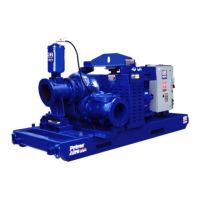OM-06704
PA SERIES
OPERATION PAGE C - 3
vacuum gauge reading will immediately drop pro
portionate to static suction lift, and should then sta
bilize. If the vacuum reading falls off rapidly after
stabilization, an air leak exists. Before checking for
the source of the leak, check the point of installa
tion of the vacuum gauge.
Priming Chamber Discharge Line
Check the priming chamber discharge line for liq
uid bypass. If bypass occurs, shut down the pump.
Refer to Maintenance and Repair, Section E and
disassemble and clean the float and valve assem
bly inside the priming chamber.
Liquid Temperature And Overheating
Overheating can occur if operated with the valves
in the suction or discharge lines closed. Operating
against closed valves could bring the liquid to a
boil, build pressure, and cause the pump to rup
ture or explode. If overheating occurs, stop the
pump immediately and allow it to completely cool
before servicing it. Approach any over‐heated
pump cautiously.
Do not remove plates, covers, gauges,
pipe plugs, or fittings from an over
heated pump. Vapor pressure within the
pump can cause parts being disen
gaged to be ejected with great force. Al
low the pump to completely cool before
servicing.
Strainer Check
Check the strainer regularly, and clean it as neces
sary. The strainer should also be checked if pump
flow rate begins to drop. Monitor and record the
vacuum suction gauge readings regularly to detect
strainer blockage.
Never introduce air or steam pressure into the
pump casing or piping to remove a blockage. This
could result in personal injury or damage to the
equipment. If backflushing is absolutely neces
sary, liquid pressure must be limited to 50% of the
maximum permissible operating pressure shown
on the pump performance curve.
STOPPING
Manual Stopping
Turn the selector switch on the control box to the
OFF position.
After stopping the pump, lock out and tag out the
control box to ensure that the pump will remain in
operative.
Automatic Stopping
In the automatic mode, the pump will stop when
the liquid in the wet well or sump lowers and acti
vates the “Off” float switch(s). The pump will restart
automatically when the liquid rises and activates
the “On” float switch(s).
PERIODIC CHECKS
Seal And Bearing Cavity Lubrication
Both the seal and bearing cavities were fully lubri
cated at the factory. Check the lubrication levels
before startup, and regularly thereafter as indi
cated in Maintenance and Repair, Section E.
When lubrication is required, use only SAE No. 30
non‐detergent oil.
Bearing Temperature Check
Bearings normally run at higher than ambient tem
peratures because of heat generated by friction.
Temperatures up to 160
F (71
C) are considered
normal for bearings, and they can operate safely to
at least 180
F (82
C).
Checking bearing temperatures by hand is inaccu
rate. Bearing temperatures can be measured ac
curately by placing a contact‐type thermometer
against the housing. Record this temperature for
future reference.
A sudden increase in bearing temperatures is a
warning that the bearings are at the point of failing
to operate properly. Make certain that the bearing
lubricant is of the proper viscosity and at the cor

